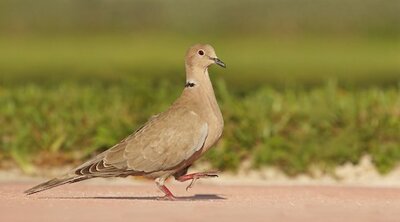Zenaida and Streptoplia-
It has come to my attention that many keepers of doves have an interest in the natural behaviors of the species that they keep- because of this I will be publishing several articles describing the life histories of the species that I have seen first-hand in the wild that are regularly found in captivity by order of genus.
Zenaida encompasses the mourning dove- as well as a few similar species such as the eared dove, zenaida (with a lower case z) dove, white-winged and Galapagos dove.
it is illegal to keep either the white-winged or mourning dove as pets within the united states and Canada (if a chick or wounded bird is found, they should be taken to a licensed wildlife rehabilitator). I do not know of any keepers outside of these regions who have acquired such birds legally either. The only species that I know that is kept legally within these countries is the Galapagos dove- which may no longer be within the bird trade.
Birds in the genus Zenaida are ground-dwelling seed-eaters with long, thin bills, overall brown coloration and typically have elongated and/or pointed tails. Most species spend significant time on the ground feeding, preening, and sitting.
If you see such a bird for sale within the United States and Canada- please make a report to your local wildlife authority or game warden.
Figure one- a mourning dove (Zenaida macroura) photo credit- Jim Merrit

Streptopelia
is the genus of "doves" most common in birdkeeping, encompassing the two near-ubiquitous species- the Eurasian and African collared (barbary) dove.
Identification
Streptopelia is a genus of sleek looking, mostly light-colored birds. The most defining feature of Streptopelia is the common "ring-neck" found in most species. This is a valuable tool for telling apart the legal Streptopelia from the illegal Zenaida. However, in juvenile and color-morph bearing birds, this does not work.
The two species common in birdkeeping (Eurasian and African collared dove) are difficult to tell apart be eye- the best way is to look at the undersides of the tails of normally colored birds, but most birds sold in pet stores and "ringneck doves" are African (see figure two)
Figure two- compare the tails of S. roseogrisea (African) and S. decaocto (Eurasian)- image taken from "Pigeons and doves" by Gibbs, Barnes and Cox.


The behavior of S. roseogrisea, the African collared dove
All of my experience with this species comes from a small population of feral birds in Miami Florida- where that can be seen perching on powerlines and walking across lawns and drinking from shallow puddles as wild birds. This species can be commonly found feeding on the seeds or turfgrass, as well as commercial birdseed underneath feeders. I have never observed this species feeding anywhere other than the ground or on the flat base of a platform feeder. While typically gregarious when feeding- the African collared dove can also be seen perching alone of powerlines to preen or simply sit. This species is rather passive and takes off if confronted by almost any other bird. I did not see any juveniles or nests in my time observing this species- but due to their close relation, it can be assumed that the behaviors around young are similar to those of the Eurasian collared dove.
While observing them- I Found this species to be rather quiet except for the occasional cooing of a male from a high perch (often a telephone pole)
Figure two- an African collared dove. photo credit Lars Petersson

The behavior of S. decaocto, the Eurasian collared dove
A far more common feral bird within the Americas- the Eurasian collared dove is the far louder, darker cousin of the African collared dove. This species is most commonly seen in loose flocks on powerlines and on the ground but is not seen alone as regularly as the African. while it's feeding habits are similar to the African (but include human refuse as well as seed) - this species is more aggressive and able to hold it's own against larger birds in struggles over food and perches. Fights are usually conducted by a pair of fighting birds striking each other with their claws and beaks in a semi-areal duel. this species commonly roosts on palm trees as well as the roofs of houses at night- but maybe also be seen on other man-made structures.
One of the easiest ways to identify this bird is its noisy, gowling call made upon landing, while this call may sound ferocious, it is a notice to other birds of a food source, rather than a threat. A similar call is also given when a bird is startled.
Cooing occurs all throughout the day but is loudest in the evening. Males coo either directly in front of females or from a high perch.
Juvenile Eurasian collared doves live around their parents until they develop their own "ringneck" and molt into adult plumage. Chicks and parents fly live together in loose flocks post-fledging when feeding, bathing, and roosting.
Platform-style nests are made near human habitation (often directly on the outsides of houses) from sticks and grasses.
Figure four- a Eurasian collared dove. photo credit- Ryan Schain

It has come to my attention that many keepers of doves have an interest in the natural behaviors of the species that they keep- because of this I will be publishing several articles describing the life histories of the species that I have seen first-hand in the wild that are regularly found in captivity by order of genus.
Zenaida encompasses the mourning dove- as well as a few similar species such as the eared dove, zenaida (with a lower case z) dove, white-winged and Galapagos dove.
it is illegal to keep either the white-winged or mourning dove as pets within the united states and Canada (if a chick or wounded bird is found, they should be taken to a licensed wildlife rehabilitator). I do not know of any keepers outside of these regions who have acquired such birds legally either. The only species that I know that is kept legally within these countries is the Galapagos dove- which may no longer be within the bird trade.
Birds in the genus Zenaida are ground-dwelling seed-eaters with long, thin bills, overall brown coloration and typically have elongated and/or pointed tails. Most species spend significant time on the ground feeding, preening, and sitting.
If you see such a bird for sale within the United States and Canada- please make a report to your local wildlife authority or game warden.
Figure one- a mourning dove (Zenaida macroura) photo credit- Jim Merrit
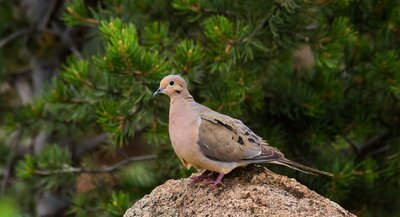
Streptopelia
is the genus of "doves" most common in birdkeeping, encompassing the two near-ubiquitous species- the Eurasian and African collared (barbary) dove.
Identification
Streptopelia is a genus of sleek looking, mostly light-colored birds. The most defining feature of Streptopelia is the common "ring-neck" found in most species. This is a valuable tool for telling apart the legal Streptopelia from the illegal Zenaida. However, in juvenile and color-morph bearing birds, this does not work.
The two species common in birdkeeping (Eurasian and African collared dove) are difficult to tell apart be eye- the best way is to look at the undersides of the tails of normally colored birds, but most birds sold in pet stores and "ringneck doves" are African (see figure two)
Figure two- compare the tails of S. roseogrisea (African) and S. decaocto (Eurasian)- image taken from "Pigeons and doves" by Gibbs, Barnes and Cox.
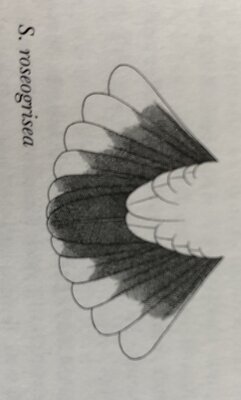
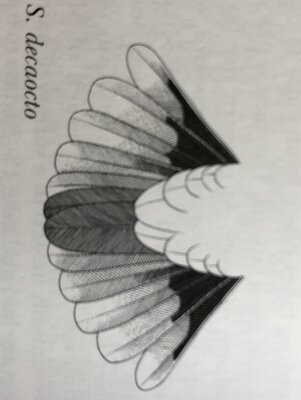
The behavior of S. roseogrisea, the African collared dove
All of my experience with this species comes from a small population of feral birds in Miami Florida- where that can be seen perching on powerlines and walking across lawns and drinking from shallow puddles as wild birds. This species can be commonly found feeding on the seeds or turfgrass, as well as commercial birdseed underneath feeders. I have never observed this species feeding anywhere other than the ground or on the flat base of a platform feeder. While typically gregarious when feeding- the African collared dove can also be seen perching alone of powerlines to preen or simply sit. This species is rather passive and takes off if confronted by almost any other bird. I did not see any juveniles or nests in my time observing this species- but due to their close relation, it can be assumed that the behaviors around young are similar to those of the Eurasian collared dove.
While observing them- I Found this species to be rather quiet except for the occasional cooing of a male from a high perch (often a telephone pole)
Figure two- an African collared dove. photo credit Lars Petersson
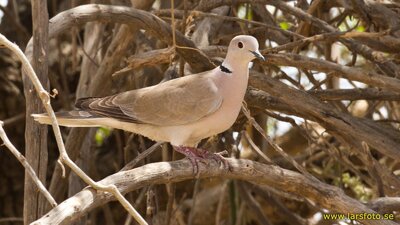
The behavior of S. decaocto, the Eurasian collared dove
A far more common feral bird within the Americas- the Eurasian collared dove is the far louder, darker cousin of the African collared dove. This species is most commonly seen in loose flocks on powerlines and on the ground but is not seen alone as regularly as the African. while it's feeding habits are similar to the African (but include human refuse as well as seed) - this species is more aggressive and able to hold it's own against larger birds in struggles over food and perches. Fights are usually conducted by a pair of fighting birds striking each other with their claws and beaks in a semi-areal duel. this species commonly roosts on palm trees as well as the roofs of houses at night- but maybe also be seen on other man-made structures.
One of the easiest ways to identify this bird is its noisy, gowling call made upon landing, while this call may sound ferocious, it is a notice to other birds of a food source, rather than a threat. A similar call is also given when a bird is startled.
Cooing occurs all throughout the day but is loudest in the evening. Males coo either directly in front of females or from a high perch.
Juvenile Eurasian collared doves live around their parents until they develop their own "ringneck" and molt into adult plumage. Chicks and parents fly live together in loose flocks post-fledging when feeding, bathing, and roosting.
Platform-style nests are made near human habitation (often directly on the outsides of houses) from sticks and grasses.
Figure four- a Eurasian collared dove. photo credit- Ryan Schain
